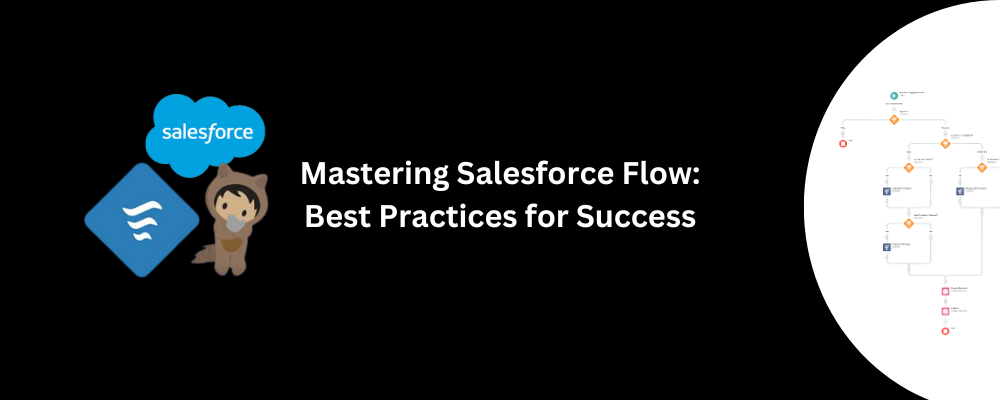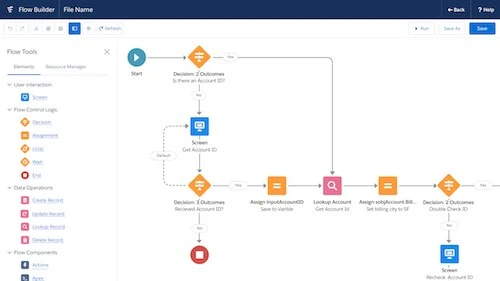Salesforce Flow is a powerful tool designed to enhance your Salesforce experience by automating complex business processes. However, to fully leverage its capabilities, it’s crucial to adhere to best practices. This guide will take you through essential Salesforce Flow best practices, helping you optimize your workflows, improve performance, and ensure maintainability.
Understanding Salesforce Flow
Salesforce Flow is a point-and-click automation tool that empowers users to automate processes within the Salesforce environment. It includes two primary types of flows: Screen Flows and Autolaunched Flows. Screen Flows involve user interactions, while Autolaunched Flows run in the background without user intervention.

Why Salesforce Flow Matters
Automating repetitive tasks and complex processes saves time and reduces errors. Salesforce Flow streamlines operations, enabling your team to focus on strategic activities. Let’s dive into the best practices to ensure your flows are efficient and effective.
1. Plan Before You Build
Before you start building a flow, it’s crucial to map out your process. Visualize each step and identify decision points. Use flowcharts or diagrams to outline the sequence of actions. Planning helps you avoid unnecessary complexity and ensures your flow meets business requirements.
2. Start Simple and Scale Up
Begin with simple flows and gradually add complexity. This approach allows you to test functionality and ensure each component works correctly before integrating it into more complex processes. Scaling up incrementally helps maintain control over the flow’s behavior.
3. Use Subflows for Reusability
Subflows are smaller, reusable flows that can be invoked from other flows. By breaking down complex processes into subflows, you enhance maintainability and reduce redundancy. Subflows promote modular design and make troubleshooting easier.
4. Optimize for Performance
Performance is critical in Salesforce Flow. To optimize your flows:
- Limit Data Fetching: Only query the data you need.
- Bulkify Your Flows: Design your flows to handle bulk data processing efficiently.
- Minimize DML Statements: Reduce the number of Data Manipulation Language (DML) operations to avoid hitting governor limits.
5. Ensure Error Handling
Implement robust error handling to manage exceptions gracefully. Use Fault Connectors to specify actions when errors occur. Logging errors and notifying users or administrators helps in timely resolution and ensures your flow continues to operate smoothly.
6. Leverage Flow Builder’s Debugging Tools
Salesforce provides debugging tools within Flow Builder. Utilize these tools to test and debug your flows. Step through each action to identify issues and validate logic. Debugging ensures your flows perform as expected in various scenarios.
7. Document Your Flows
Maintain comprehensive documentation for each flow. Include details about the flow’s purpose, logic, inputs, outputs, and any dependencies. Documentation aids in future maintenance and helps new team members understand the flow’s functionality.
8. Use Naming Conventions
Adopt consistent naming conventions for your flows, variables, and elements. Clear, descriptive names make it easier to understand the flow’s structure and purpose. Naming conventions enhance readability and maintainability.
9. Utilize Comments for Clarity
Add comments within your flows to explain complex logic or critical steps. Comments serve as in-line documentation, providing context and clarity. They are invaluable during troubleshooting and future updates.
10. Test Thoroughly
Thorough testing is essential to ensure your flow works correctly in all scenarios. Create test cases for different paths and conditions. Test with real data to validate accuracy and performance. Comprehensive testing prevents unexpected issues in production.
11. Monitor and Optimize Over Time
Regularly monitor the performance of your flows. Analyze usage patterns and identify areas for optimization. Salesforce Flow evolves, and continuous improvement helps you stay aligned with best practices and new features.
12. Collaborate and Share Knowledge
Encourage collaboration within your team. Share insights, tips, and best practices. Conduct regular reviews and knowledge-sharing sessions. A collaborative approach fosters innovation and enhances overall flow quality.
13. Stay Updated with Salesforce Releases
Salesforce regularly updates its platform with new features and improvements. Stay informed about these updates and assess how they impact your flows. Incorporating new capabilities can enhance efficiency and functionality.
14. Prioritize Security
Ensure your flows adhere to security best practices. Implement data validation and enforce field-level security. Restrict access to sensitive data and actions based on user roles and permissions.
15. Seek Feedback and Iterate
Solicit feedback from users and stakeholders to understand their experience with your flows. Use this feedback to iterate and improve. Continuous refinement ensures your flows meet evolving business needs and deliver optimal performance.
Conclusion
Mastering Salesforce Flow requires a blend of strategic planning, technical know-how, and continuous improvement. By following these best practices, you can create efficient, reliable, and maintainable flows that drive business success. Embrace the power of automation with Salesforce Flow and transform your business processes for the better.
FAQs
1. What are the different types of Salesforce Flows? Salesforce Flows are primarily divided into Screen Flows, which require user interaction, and Autolaunched Flows, which run automatically without user intervention.
2. How can I improve the performance of my Salesforce Flow? To enhance performance, limit data fetching, bulkify your flows, and minimize DML statements. This reduces processing time and avoids hitting governor limits.
3. Why is error handling important in Salesforce Flow? Error handling ensures that your flow can manage exceptions gracefully, logging errors, and notifying relevant parties to resolve issues promptly, maintaining smooth operation.
4. What is the benefit of using subflows? Subflows promote reusability and modular design. They simplify complex processes, making your main flow more manageable and easier to maintain.
5. How do I stay updated with Salesforce Flow best practices? Stay informed by following Salesforce release notes, participating in community forums, and attending webinars. Continuous learning helps you incorporate new features and best practices into your flows.




